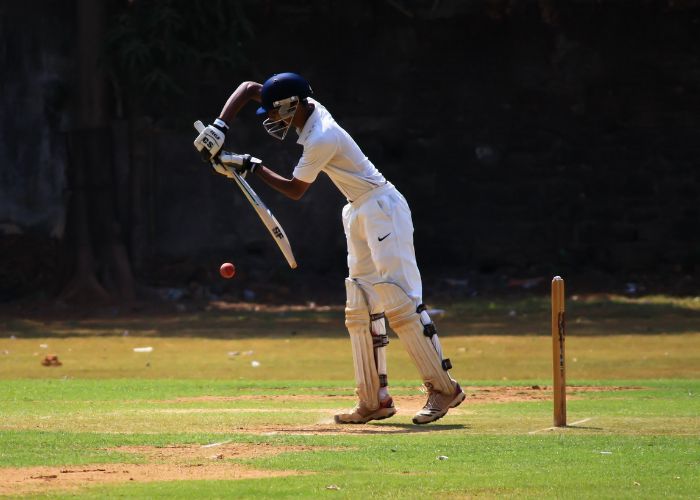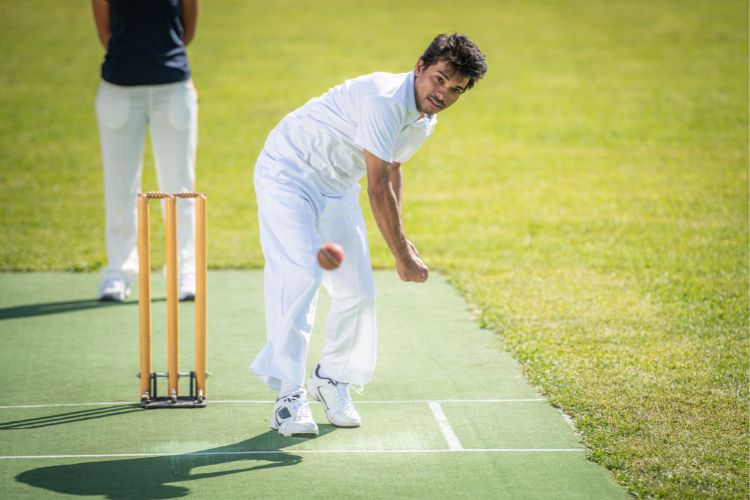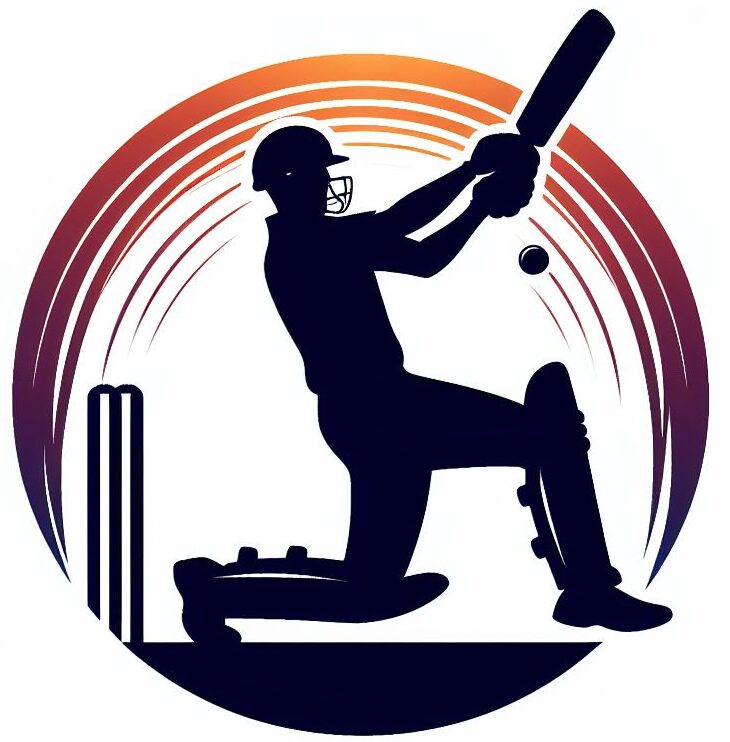We talked recently about How to Hold A Cricket Bat. Now, we’ll start on a series of how to use that cricket bat to attack and defend.
The back foot defence stands as a cornerstone of your cricket batting technique, essential in those tough and torrid times when you are withstanding the challenges posed by varied bowling attacks.
We know that the front foot defence involves stepping forwards to meet the ball, so, obviously, the back foot defence requires you, as the batter, to play the ball while remaining on the back foot.
This shot is particularly important when facing fast bowlers delivering short-pitched deliveries, or spinners who are extracting extra bounce from the pitch than you might ordinarily expect.
The evolution of the back foot defence can trace itself back to the early days of cricket, when groundskeepers – if, indeed, there were any – didn’t have the equipment available to today’s groundskeepers. And when pitches weren’t covered by protective covers to keep the rain off.
Cricket pitches were far rougher and far less predictable than they are today. Batters quickly realized the importance of playing off the back foot to allow themselves the time to counter the variable bounce and pace of the ball. As cricket equipment and playing surfaces evolved and improved, so too did batter’s back foot defence techniques. Every generation of batters refined their skills to adapt to the changing bowling tactics and pitch conditions.
Understanding the value of a robust defence on the back foot for batting longevity
If you want to play a long innings, as a batter you must have a robust defence … both back foot and front foot. It is the only way you can survive those tough bowling spells where the bowler seems to have your measure. Everyone loves the shots that bring up the boundaries and sizes, but to get to that point, you have to defend the difficult balls.
By mastering back foot defence, along with front foot defence, you can effectively nullify the threat posed by aggressive bowling, giving you time to settle at the crease, and assess and adjust to the conditions.
The fundamentals of footwork for a solid back foot defence
Footwork is the foundation of any cricket shot, so, of course, back foot defence is no exception. As a batter, you must master the art of moving swiftly and decisively onto the back foot to play defensive shots with precision and control. The key to this is to maintain your balance and stability during the transference of weight on to your back foot.
This will allow you to react quickly to deliveries that are pitched short and fast, or those that are spinning sharply off the pitch. Proper footwork ensures that you remain in the best position to play the ball under all conditions.
So, to perform a back foot defensive shot, move your back foot back and across to align yourself correctly to the line of the ball. Your front foot should then move back to meet your back foot, giving you strong stability at the time of the shot.
Your head should be behind the line of the ball, but positioned in front of your back foot, as this gives you greater balance. Your front elbow should be high, allowing you to get your hands well above the bounce of the ball.
With this high front elbow, you are then able to present a vertical bat to the ball, with the face of the bat angled down towards the pitch. This is a compact position, bat near the body, head in line with the bat and the ball, and it provides a great stable base to allow you to control your shot and survive the short delivery.
When to defend, when to attack from the back foot
Shot selection is a strategic aspect of back foot defence. It requires you, as the batter, to make split-second decisions based on the line, length and pace of the ball being bowled to you. While it is true that the primary objective of back foot defence is to protect your wicket and survive challenging bowling spells, there are times when you can capitalize on scoring opportunities from the back foot.

This transition from defence to attack requires a keen understanding of the game situation, the condition of the pitch and the strengths and weaknesses of both the bowler and the fielder positions.
In other words, it takes time and experience.
As a batter, you will need to recognize the subtle changes in the bowler’s line and length and use footwork and timing to capitalize on deliveries that are wide or slightly overpitched.
However, this ability to switch gears comes with risk. It demands a balance between caution and aggression, as it is easy to mistime a shot and lose your wicket.
The art of the back foot defence encompasses not only the technical proficiency to keep out the good balls but also the strategic know-how to capitalize on scoring chance when they arise, making it a true test of your skill and temperament.
Strategies for negotiating fast bowlers with a back foot defence

Facing pace bowling is intimidating. Getting hit with a cricket ball is painful, and obviously, it is something you will want to avoid.
But employing back foot defence strategies can provide you with the skills to handle fast bowling. Maintain a solid base and stay balanced on the back foot; this will allow you to react quickly to the pace and bounce of the ball.
Additionally, watch the ball closely. Playing the ball late on the back foot helps minimize the risk of edging the ball through to the keeper or the slips cordon.
One of the most intimidating weapons a fast bowler has is the bouncer. It is very rare to meet a batter who actually likes facing bouncer after bouncer. Those that say they like facing bouncers constantly are either acting with false bravado, or there is something a little wrong in their head.
Seriously, though, a bouncer is designed to unsettle a batter and to induce mistakes, usually because the batter is trying to protect themselves first and foremost, rather than playing the ball with any degree of confidence.
When playing a bouncer, you need to make quick decisions. Either you are going to play the ball, or you are going to sway or duck out of the balls path.
Batters get in trouble when they change their mind between the two as the ball nears them. You need to stay composed. By doing so, by taking a course of action and sticking to it, you can effectively counter short-pitched bowling, allowing you to wait for when the bowler gets tired and offers up a poor ball.
Mastering Back Foot Defence Against Spin
Playing spinners off the back foot requires a nuanced approach. Sometimes, when you are not sure of what the ball is doing, which way it is spinning, or how much it is going to bounce, you need to play back to allow you more time.
You have 4 feet between the batting crease and the stumps. Obviously, you don’t want to step on the stumps, but the depth of the crease is important for you, as the batter, to utilize.
Going forward or going back deep into your crease, is a way you can disrupt the line and length of the spinner’s deliveries. Putting the bowler in two minds as to how they will bowl to you, helps you to dictate terms and increases the opportunity for balls that are too short or too full.
Back foot defence against spin can sometimes seem a battle of attrition. By exercising restraint and choosing your shots judiciously, you can frustrate the bowler and gradually assert control over the bowling.
Final Thoughts On Back Foot Defence
Back foot defence is not glamourous. You are not going to get on to the highlight reels with a great backfoot defensive shot. But it, along with the front foot defensive shot, will allow you to survive long enough to get the opportunity to hit those fours and sixes.
Practice by yourself in front of a mirror, and in the nets with someone throwing a ball to you, or against real bowlers, and over time, back foot defence will become almost instinctive.
Thank you for making it to the end of this post. If you have any interesting stories or comments to make, leave them in the comment box below.

